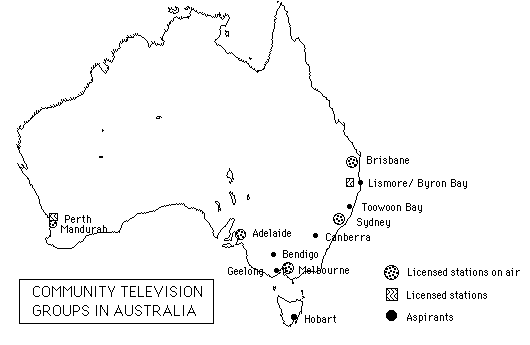Australian Community Television - 1995
INTRODUCTION
Community Broadcasting is well established in Australia, with the sector in place for over 21 years. Community television is the new kid on the block. Both radio and television are represented by the Community Broadcasting Association of Australia (CBAA), the national representative body for the sector.
Community television includes free to air services, prospective cable operators and potentially others delivered by satellite, MDS, or new technologies yet to be developed. It provides access and equity to the television medium, enabling the Australian community to participate, learn, create and most importantly, communicate in audio visual media. After one year of operation, community television is producing more Australian content than any other television service per week. It allows the development of new and innovative television ideas to become a valuable product and provides a place to develop skills and talent.
FACTS AND FIGURES:
Community Television in itŐs first year of operation:
has a cumulative audience of 455,000 per week in Melbourne (as found by Roy Morgan Research).
has an estimated audience of one million viewers per week nationally.
broadcasts between 75 - 98 % Australian content per week.
produces 165 hours of Australian content per week.
provides regular training for hundreds of individuals.
has encouraged the formation of over one hundred production groups nationally.
WHERE IS IT:

Five stations have been on air for one year. Within this time they have developed rapidly despite limited resources and infrastructure.
WHAT IS IT:
Community television operates in accordance with community broadcasting objects and codes of practice. It is similar to community radio but utilises the television medium.
WHAT IT OFFERS:
Community television is creating new and innovative ways of providing a service to a viewing audience that is looking for something different. It benefits the Australian community, government, industry, business, and the education sector.
Community televisionŐs key features are:
non-discriminatory access
community participation in all areas of television operations
Audience:
It is estimated that one million viewers watch community television sometime each week.
Whilst catering for a diverse range of viewing tastes, community television;
targets a niche audience
services local areas
allows audience participation
Training Education & Employment:
Community televisionŐs hands-on experience offers unique training, employment and educational opportunities. In particular;
technical literacy (learning to use technology to communicate)
effective entry level training
interactive educational programming
community self empowerment
employment
schools and university based production groups
Already, significant numbers of CTVvolunteers have moved into further education and employment within the media, and related industries.
Australian Content:
CTV offers the Australian community a new form of cultural expression, programming schedules feature;
75 -98% Australian content
diverse programming
innovative & experimental programs
educational & informative material
multicultural programs
indigenous media
programs by disadvantaged and disenfranchised groups
low cost operations and production
programming by the local community
a showcase for Australian independent film and video
Innovation and Culture:
Community television offers a unique environment for the development of innovative
programming by;
providing for the participation of diverse programming groups
facilitating efficient use of resources
favouring new ideas over traditional production formats.
FINANCE
Whilst community television is recognised as a cultural service in the Federal GovernmentŐs policy, Creative Nation, it has no source of government funding. It is totally self funded through sponsorship announcements and sale of airtime.
Community television contributes over 20% of it's income, to the Federal.
The biggest obstacles to the effective development of CTV at present are:
prohibition on Federal Government funding
commercial level fees set by Government agencies
lack of technical and administrative infrastructure support
lack of resources
lack of audience education showing how to tune in
Sixth Channel Inquiry
The battle for CTV has been a lengthy one but finally CTV has been able to broadcast on on a temporary basis on the ŇSixth ChannelÓ. However the imminent review into the Sixth Channel means CTV does not have any security for itŐs future. Your support is needed to keep the Sixth Channel available for community access.
HOW YOU CAN HELP
contact your
local CTV station for its suggestions
become a member
promote CTV on your radio station
write letters of support
